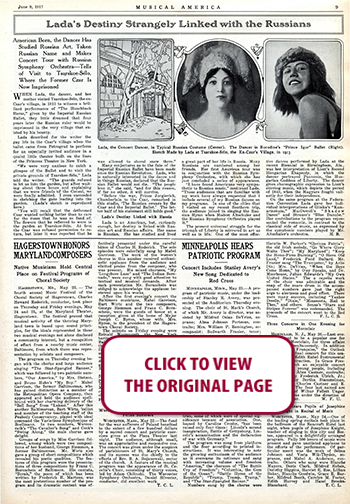 100 YEARS AGO IN MUSICAL AMERICA (191)
100 YEARS AGO IN MUSICAL AMERICA (191)
June 9, 1917
Page 9
Lada’s Destiny Strangely Linked with the Russians
American Born, the Dancer Has Studied Russian Art, Taken Russian Name and Makes Concert Tour with Russian Symphony Orchestra—Tells of Visit to Tsarskoe-Sélo, Where the Former Czar Is Now Imprisoned
WHEN Lada, the dancer, and her mother visited Tsarskoe-Sélo, the ex-Czar’s village, in 1913 to witness a brilliant performance of “The Hunchback Horse,” given by the Imperial Russian Ballet, they little dreamed that four years later the Russian ruler would be imprisoned in the very village that existed by his bounty.
Lada described for the writer the gay life in the Czar’s village when the ballet came from Petrograd to perform for an especially invited audience in a quaint little theater built on the lines of the Princess Theater in New York.
“We were very anxious to catch a glimpse of the Ballet and to visit the private grounds of Tsarskoe-Sélo,” Lada told the writer. “The guards refused to let us into the garden, but after waiting about three hours and explaining that we were friends of the Consul, we were finally admitted. I even succeeded in sketching the gate leading into the garden. (Lada’s sketch is reproduced here.)
“You will recall that the dethroned Czar wanted nothing better than to care for the roses that he was so fond of. The flowers that he referred to were in the garden at Tsarskoe-Sélo. At first the Czar was refused permission to return, but later it was reported that he was allowed to shovel snow there.”
Many conjectures as to the fate of the Imperial Russian Ballet have been made since the Russian Revolution. Lada, who is naturally interested in the dance and in things Russian, declared that the Russian Ballet would not die. “The people love it,” she said, “and for this reason, if for no other, it will survive.
“Before the war, Prince Jurgievich, Chamberlain to the Czar, remarked in this studio, ‘The Russian swears by the Czar and the Imperial Ballet.’ The latter half of his statement still holds good.”
Lada’s Destiny Linked with Russia
Lada is an American, but, curiously enough, her destiny is linked with Russian art and Russian affairs. Her name is Russian. She has studied and lived a great part of her life in Russia. Many Russians are numbered among her friends. Her first American tour was in conjunction with the Russian Symphony Orchestra, with which she has just concluded a series of appearances.
“I have found Americans very sympathetic to Russian music,” continued Lada. “Those audiences that are familiar with my work have always requested that I include several of my Russian dances on my programs. In one of the cities that I visited on my recent Southern trip, the audience joined in singing the Russian Hymn when Modest Altschuler and the Russian Symphony Orchestra played it.”
The present universal struggle for the triumph of Liberty is mirrored in art as well as in life. One of the most effective dances performed by Lada at the recent Biennial in Birmingham, Ala., was her interpretation of Liszt’s Second Hungarian Rhapsody, in which the dancer portrayed Pannonia, the Hungarian Goddess of Liberty. The dancer gives choreographic expression to Liszt’s stirring music, which depicts the period of 1849, when the Magyars fought valiantly for their independence.
On the same program at the Federation Convention Lada gave her individual interpretations of Glinka‘s “Kamarinskaia,” MacDowell’s “Shadow Dance” and Strauss’s “Blue Danube.” Her contributions to the program represented the romantic, in contrast to the classical side of music, as expressed by the symphonic numbers played by Mr. Altschuler’s orchestra. —H.B.




 RENT A PHOTO
RENT A PHOTO





